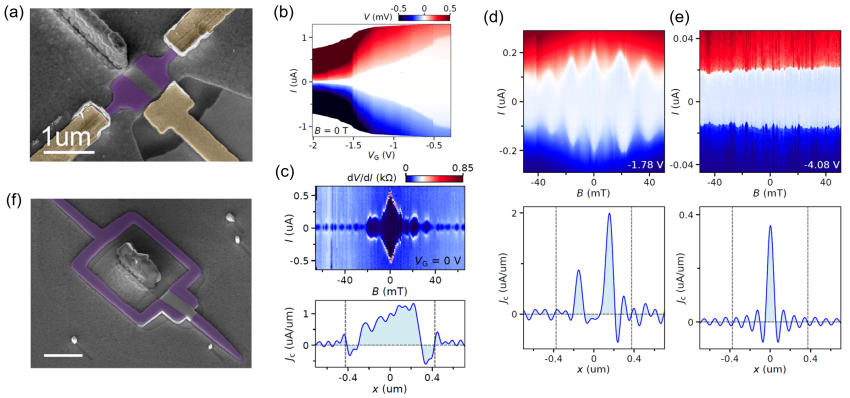Semiconductor-superconductor hybrids can host intriguing phases of matter such as Majorana zero modes. One example is planar Josephson junctions (JJs) based on a two dimensional electron gas (2DEG) coupled to a superconductor. Compared to nanowire proposals, the advantage of this 2D approach is the tunable phase bias, which could lower the critical magnetic field for Majoranas. The 2DEG materials in previous studies are InAs, InSb, and HgTe. Recently, a team led by Prof. Ke He and Prof. Hao Zhang has realized planar JJs based on a new material combination of PbTe-Pb.
The PbTe film was grown via selective area epitaxy, followed by the in situ deposition of superconductor Pb. Shadow wall epitaxy was used to define the junction region. Transport measurement reveals gate-tunable supercurrent. The supercurrent oscillates in an out-of-plane magnetic field. The oscillation pattern is Fraunhofer-like at positive gate voltages and SQUID-like at negative gate voltages. The Fraunhofer-like oscillations suggests a nearly uniform spatial distribution of the critical supercurrent density, characteristic of a planar JJ. The SQUID-like oscillations suggest two peaks in the distribution whose origin is unclear. Tunneling devices for Majorana detection could also be realized using this technique (panel f in the figure below). A PbTe nanowire loop forms an ac SQUID, enabling the phase biasing of the planar JJ.

(a) Scanning electron micrograph of a PbTe-Pb planar JJ device. (b) Gate-tunable supercurrent at zero field. (c-e) Supercurrent oscillations in a magnetic field and the extracted critical supercurrent distribution. (f) Prototype device for Majorana detection.
The work, entitled “Selective-Area-Grown PbTe-Pb Planar Josephson Junctions for Quantum Devices”, is published in Nano Letters. The first authors are graduate students of the Physics Department: Ruidong Li, Wenyu Song, Wentao Miao and Zehao Yu. Corresponding authors are Prof. Ke He and Prof. Hao Zhang. The work is supported by the National Natural Science Foundation of China, Ministry of Science and Technology of China, Tsinghua University Initiative Scientific Research Program, Beijing Municipal Science and Technology Commission, Hefei National Laboratory, and the Innovation Program for Quantum Science and Technology.
Paper Link: https://pubs.acs.org/doi/10.1021/acs.nanolett.4c00900